Adidas vs Nike Running Shoes
Last Updated: January 01, 2025 | Author: Jake Thompson
Isn't it intriguing how two brands can so dominantly define the landscape of sports and lifestyle wear? As a professional writer with a focus on the dynamics of the fashion industry, I've always found the Adidas or Nike debate to be a rich ground for analysis.
Both brands have not only competed in creating the most innovative sportswear but have also become emblematic of cultural trends and consumer identity. In dissecting this rivalry, I've come to appreciate the subtleties of their marketing strategies and the depth of their brand philosophies.
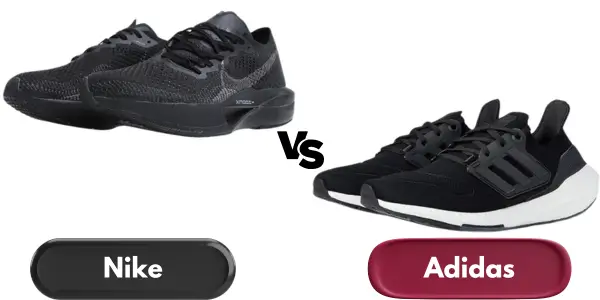
The question of which brand ultimately wears the crown is complex, woven with threads of historical achievement, celebrity endorsements, and breakthrough technologies. As we peel back the layers of this global contest, you'll find that the stakes are higher than ever, and the outcome may just redefine the future of athletic wear.
Let's examine the factors that continue to fuel this corporate showdown, and perhaps we'll uncover where your loyalties might align in this ongoing battle for the title of the world's top sports brand.
Table of Contents:
- Key Takeaways
- Table: Nike vs Adidas
- History & Growth
- Market Presence Analysis
- Technological Innovations
- Revenue
- Adidas vs Nike Market Share
- Performance Comparison
- Stability & Support
- Durability
- Features Comparison
- Cushioning
- Breathability
- Adidas vs Nike Shoes Size Chart
- Our Recommendations
- Final Verdict
- Frequently Asked Questions
Key Takeaways
- - Adidas and Nike are the top competitors in the sneaker market, with strong brand presence and loyal consumer bases.
- - Nike has a larger market share and higher revenue compared to Adidas.
- - Both brands utilize innovative technologies in their products, such as Nike's ZoomX and Adidas' Boost.
- - Nike focuses on social media advertising and collaborations with celebrities, while Adidas emphasizes product innovation and sustainability.
Table: Nike vs Adidas
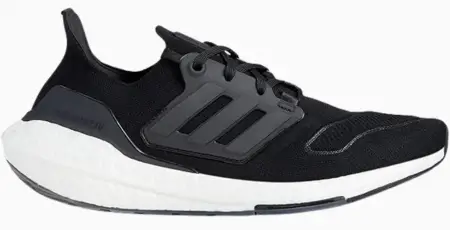
|
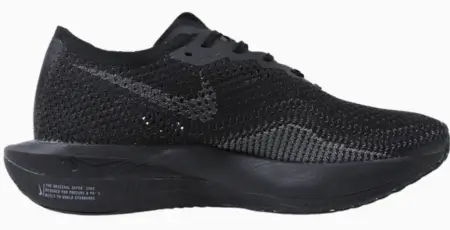
|
|
|---|---|---|
| Criteria | Adidas | Nike |
| Founded | 1924 in Herzogenaurach, Germany | 1964 in Eugene, Oregon, USA |
| Founders | Adolf Dassler | Bill Bowerman and Phil Knight |
| Key Products | Sportswear, shoes, accessories, equipment | Sportswear, shoes, accessories, equipment |
| Technology | Boost, Primeknit, Torsion system | Air Max, Flyknit, Dri-FIT |
| Market Share | Significant in Europe, growing globally | Dominant globally, especially in USA |
| Innovation | Focus on sustainability, Parley Ocean Plastic products | Nike Adapt (self-lacing shoes), Nike+ platform |
| Revenue | Lower than Nike but has substantial growth | Higher than Adidas, market leader |
| Brand Value | Highly valued, known for classic designs and collaborations | World's most valuable sports brand |
| Price |
History & Growth
Tracing back to its origins, Adidas began its journey in 1924, a full four decades before Nike entered the competitive sportswear market in 1964. The Dassler brothers laid the foundation for Adidas, initially focusing on athletic footwear.
In contrast, Nike, originating as Blue Ribbon Sports, was the brainchild of Phil Knight and Bill Bowerman, revolutionizing the market with innovative designs and aggressive marketing strategies. Nike's market share soared with the introduction of the Air Jordan line, a testament to their branding prowess.
Meanwhile, Adidas has consistently fortified its presence through strategic partnerships and diversified offerings.
Analyzing their trajectories, it's clear that both brands have aggressively pursued growth, yet Nike has gained a substantial edge in the global arena through relentless innovation and marketing.
Related: Best Nike Outdoor Basketball Shoes
Market Presence Analysis
While reflecting on the historical growth of the two giants, it's crucial to examine their current market presence to understand how their strategies have shaped their global footprints.
Market presence analysis reveals that both Nike and Adidas maintain a strong presence in key regions, including North America and Europe. As leading running shoe brands, they've carved out significant market shares with a variety of sports shoes and shoe models.
Nike, in particular, has leveraged its innovative sports apparel to dominate the North American market, while Adidas has solidified its position in Europe.
Data-driven insights indicate both brands are expanding in emerging markets, reinforcing their status as behemoths in the athletic wear industry.
Technological Innovations
Frequently, the technological advancements pioneered by Nike and Adidas have set industry benchmarks, underscoring their commitment to innovation in athletic footwear. Both brands have made strides in developing materials and designs that enhance performance, comfort, and energy return.
| Nike Advancements | Adidas Advancements |
|---|---|
| ZoomX foam for responsive cushioning | Boost foam for high energy return |
| Carbon fiber plate for propulsion | Thermoplastic polyurethane for durability |
| Air cushioning for impact protection | Energy return optimized through material engineering |
| Lightweight and durable materials | Innovative design for adaptive support |
Revenue
When assessing the revenue, it's crucial to consider their market share and financial performance.
In 2022, Adidas reported an annual revenue of 22.5 billion euros, whereas Nike's revenue in 2022 reached $42.65 billion, underscoring the latter's larger slice of the global market.
This stark contrast in revenue not only reflects their competitive positioning but also highlights the differing strategies and market penetrations of the two sportswear giants.
Adidas vs Nike Market Share
In terms of market share, Nike leads with a notable revenue of $42.65 billion in 2022, surpassing Adidas's 22.5 billion euros. Analyzing the competitive landscape, it's clear that:
- - Nike's dominance is bolstered by strong sales in sneakers and running shoes, categories where they've innovated consistently.
- - Adidas maintains a significant market share, focusing on sustainability and leveraging celebrity endorsements effectively.
- - The sneaker market is a battleground where both brands unleash cutting-edge designs and technology.
- - Nike's extensive global reach amplifies its market presence, which is reflected in its higher revenue figures.
- - Adidas, though trailing behind Nike in revenue, has a dedicated consumer base and remains a key player in the industry.
Performance Comparison
When assessing the performance, particularly in the realm of stability and support, it's crucial to consider empirical data and user feedback.
I've scrutinized various studies and consumer reviews that highlight the distinct approaches each brand takes to enhance athletic performance.
This analysis will focus on the engineering of shoe structures, such as the heel counter and midsole composition, which contribute to the overall stability and support offered by both companies.
Stability & Support
Assessing stability and support, both brands integrate advanced technologies to enhance runner's performance, each with distinctive approaches to achieving a secure and stable ride.
Here's what I've found in my analysis:
- - Adidas running shoes often features a midsole with Boost technology, providing not just cushion but also responsiveness and energy return.
- - Nike shoes leverage various cushioning systems, including the renowned Air units, which offer a different type of stability.
- - The shoe design elements, like the heel counter in some Nike models, provide a locked-in fit, while Adidas may use a stiffer heel design for added support.
- - Adidas sometimes incorporates a stiffer midsole material on the medial side for overpronation control.
- - Both brands engineer their footwear with specific zones in the midsole for targeted stability during the gait cycle.
Durability
How does the durability of Nike and Adidas running shoes compare when subjected to the rigors of daily use?
In the running world, the longevity of new shoes is pivotal. Analyzing customer reviews and material composition, shoes tend to vary in durability. Differences between Adidas and Nike often surface in trail running shoes, where robustness is essential.
Nike vs Adidas running shoes both incorporate recycled materials, yet their resilience differs. Adidas, known for its Boost technology, tends to maintain cushioning over extensive mileage. Nike's innovative materials also promise lasting performance. However, empirical data suggests that the lifespan of running shoes, regardless of brand, is largely contingent upon running habits, care, and individual gait patterns.
Features Comparison
When comparing features such as cushioning and breathability, it's essential to examine the data behind the materials and design.
I've observed that Adidas' Boost technology offers substantial energy return, whereas Nike's ZoomX foam is designed for lightness and speed.
The breathability of each brand's footwear also hinges on the use of innovative fabrics that manage moisture and airflow, impacting athletic performance and comfort.
Cushioning
In comparing the cushioning features of both brands running shoes, it's crucial to note that while Adidas' Boost technology offers a highly responsive feel, Nike's cushioning varies across their range, incorporating air units and proprietary foams for targeted performance benefits.
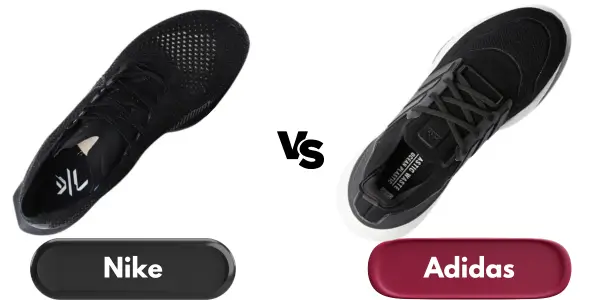
Here's an analytical breakdown:
- - Adidas Boost: Utilizes TPU for energy return, notably in the Yeezy Boost and other performance models.
- - Nike Air: Features air units that are especially beneficial in heel and midfoot cushioning.
- - Nike Vapor Fly: Equipped with ZoomX foam for a race shoe that provides exceptional energy return.
- - Trail Running: Both brands offer specialized cushioning for rugged terrain, ensuring stability and comfort.
- - EVA Foam: Adidas often opts for Boost over traditional EVA foam for its superior responsiveness.
Breathability
I'll start by examining the breathability features, highlighting their design approaches and materials used to enhance airflow and reduce moisture buildup during performance.
Both brands have engineered their Adidas and Nike running shoes with breathable materials and mesh designs to keep your feet cool and dry. Nike utilizes engineered mesh and perforated foam, while Adidas often incorporates its Primeknit fabric, which is known for its ventilation properties.
Elite running models are specifically designed to manage the heat generated with each foot strike. This is achieved through the strategic placement of vents and the use of lightweight, moisture-wicking fabrics.
Both brands have made significant strides in creating shoes designed to offer superior breathability, aiming for a balance between support and airflow.
Adidas vs Nike Shoes Size Chart
Men’s sizes chart
| Adidas | Nike | Adidas | Nike | Adidas | Nike | Inches | cm |
|---|---|---|---|---|---|---|---|
| EU | EU | US | US | UK | UK | ||
| 36 | 36 | 4 | 4 | 3.5 | 3 | 8 11/16 | 22 |
| 36 2/3 | 36.5 | 4.5 | 4.5 | 4 | 3.5 | 8 7/8 | 22.5 |
| 37 1/3 | 37.5 | 5 | 5 | 4.5 | 4 | 9 1/16 | 23 |
| 38 | 38 | 5.5 | 5.5 | 5 | 4.5 | 9 1/4 | 23.5 |
| 38 2/3 | 38.5 | 6 | 6 | 5.5 | 5 | 9 7/16 | 24 |
| 39 1/3 | 39 | 6.5 | 6.5 | 6 | 5.5 | 9 5/8 | 24.5 |
| 40 | 40 | 7 | 7 | 6.5 | 6 | 9 13/16 | 25 |
| 40 2/3 | 40.5 | 7.5 | 7.5 | 7 | 6.5 | 10 1/16 | 25.5 |
| 41 1/3 | 41 | 8 | 8 | 7.5 | 7 | 10 1/4 | 26 |
| 42 | 42 | 8.5 | 8.5 | 8 | 7.5 | 10 7/16 | 26.5 |
| 42 2/3 | 42.5 | 9 | 9 | 8.5 | 8 | 10 5/8 | 27 |
| 43 1/3 | 43 | 9.5 | 9.5 | 9 | 8.5 | 10 13/16 | 27.5 |
| 44 | 44 | 10 | 10 | 9.5 | 9 | 11 | 28 |
| 44 2/3 | 44.5 | 10.5 | 10.5 | 10 | 9.5 | 11 1/4 | 28.5 |
| 45 1/3 | 45 | 11 | 11 | 10.5 | 10 | 11 7/16 | 29 |
| 46 | 45.5 | 11.5 | 11.5 | 11 | 10.5 | 11 5/8 | 29.5 |
| 46 2/3 | 46 | 12 | 12 | 11.5 | 11 | 11 13/16 | 30 |
| 47 1/3 | 47 | 12.5 | 12.5 | 12 | 11.5 | 12 | 30.5 |
| 48 | 47.5 | 13 | 13 | 12.5 | 12 | 12 3/16 | 31 |
Women’s sizes chart
| Adidas | Nike | Adidas | Nike | Adidas | Nike | Inches | cm |
|---|---|---|---|---|---|---|---|
| Eur | Eur | Us | Us | Uk | Uk | ||
| 36 | 35.5 | 5 | 5 | 3.5 | 2.5 | 8 11/16 | 22 |
| 36 2/3 | 36 | 5.5 | 5.5 | 4 | 3 | 8 7/8 | 22.5 |
| 37 1/3 | 36.5 | 6 | 6 | 4.5 | 3.5 | 9 1/16 | 23 |
| 38 | 37.5 | 6.5 | 6.5 | 5 | 4 | 9 1/4 | 23.5 |
| 38 2/3 | 38 | 7 | 7 | 5.5 | 4.5 | 9 7/16 | 24 |
| 39 1/3 | 38.5 | 7.5 | 7.5 | 6 | 5 | 9 5/8 | 24.5 |
| 40 | 39 | 8 | 8 | 6.5 | 5.5 | 9 13/16 | 25 |
| 40 2/3 | 40 | 8.5 | 8.5 | 7 | 6 | 10 1/16 | 25.5 |
| 41 1/3 | 40.5 | 9 | 9 | 7.5 | 6.5 | 10 1/4 | 26 |
Our Recommendations
Adidas Ultraboost vs Nike Pegasus
The Adidas Ultraboost 5.0 offers superior comfort with its Boost midsole, ideal for long runs and casual wear, while the Nike Pegasus 40, with its React foam, provides a balance of cushioning and responsiveness, catering to a variety of training styles and runners.

|
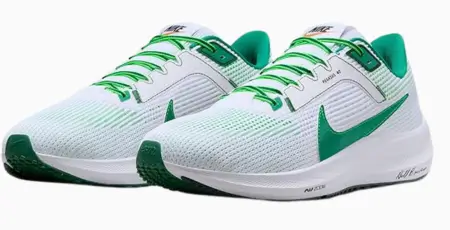
|
|
|---|---|---|
| Feature | Adidas Ultraboost 5.0 | Nike Pegasus 40 |
| Upper Material | Primeknit+ | Engineered Mesh |
| Midsole | Boost Cushioning | Nike React Foam |
| Outsole | Stretchweb with Continental Rubber | Rubber with Waffle Pattern |
| Cushioning | High | Moderate |
| Stability | Neutral, with Torsion System | Neutral, with Flywire Technology |
| Fit | Snug, sock-like fit | Standard fit with more toe room |
| Weight (approx.) | 11 oz | 9.7 oz |
| Use | Long-distance running, casual wear | Versatile, running and training |
| Price |
Nike ZoomX VaporFly vs Adidas Terrex Agravic Ultra Trail
The Nike ZoomX VaporFly 3 is a road running shoe known for its speed and energy return, ideal for marathons, while the Adidas Terrex Agravic Ultra Trail is a durable trail running shoe designed for grip and protection in off-road conditions.
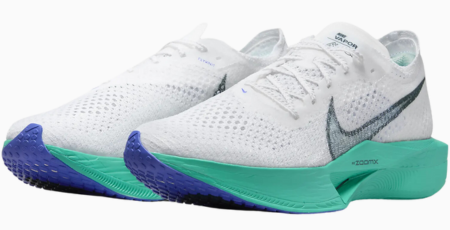
|

|
|
|---|---|---|
| Feature | Nike ZoomX VaporFly 3 | Adidas Terrex Agravic Ultra Trail |
| Upper Material | Engineered mesh or VaporWeave | Abrasion-resistant mesh |
| Midsole | ZoomX Foam | Lightstrike EVA and Boost cushioning |
| Outsole | Rubber with integrated traction pad | Continental Rubber with lugs |
| Cushioning | Maximum, responsive | Balanced, trail-specific |
| Stability | Neutral, with a carbon fiber plate | Neutral, designed for uneven terrain |
| Fit | Snug and supportive | Secure, with reinforced areas |
| Weight (approx.) | 184g | 312g |
| Use | Competitive road racing | Trail running, long distance |
| Price |
Nike Free Flyknit vs Adidas Ultraboost
The Nike Free Flyknit offers a lightweight, flexible, and natural running experience, ideal for short distances and minimalistic runners, while the Adidas Ultraboost 22 provides high energy return and plush cushioning, suited for longer runs and those seeking more support and comfort.
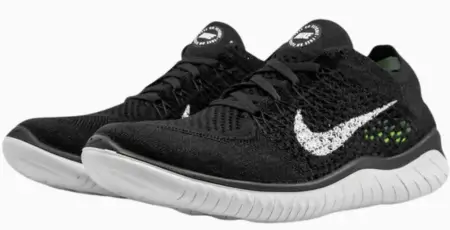
|

|
|
|---|---|---|
| Feature | Nike Free Flyknit 2018 | Adidas Ultraboost 22 |
| Upper Material | Flyknit | Primeknit+ |
| Midsole | Soft foam | Boost cushioning |
| Outsole | Laser-cut siping on foam | Continental Rubber Stretchweb |
| Cushioning | Moderate, flexible | High, responsive |
| Stability | Neutral, flexible design | Neutral, with Linear Energy Push |
| Fit | Snug, sock-like | Snug, supportive |
| Weight (approx.) | 184g | 332g |
| Use | Running, training, casual wear | Running, long-distance, casual wear |
| Price |
Final Verdict
In the grand rivalry of Adidas vs Nike, it's not just about which brand is the best overall, but rather which excels in specific areas. Nike takes the lead with superior innovation, market share, and a diverse range of technologically advanced products, making it a top choice for those seeking the latest in sportswear technology and style. Adidas, however, stands out in sustainability and durability, appealing to those who prioritize environmental responsibility and long-lasting quality in their sportswear. Your choice between Adidas and Nike will depend on what you value more: Nike's cutting-edge appeal or Adidas' commitment to sustainability and durability.
Frequently Asked Questions
1. What are the key differences between Adidas and Nike running shoes?
Adidas and Nike are two leading brands in athletic footwear. When comparing their running shoes, Adidas often features the Boost technology, known for its comfort and energy return, whereas Nike's running shoes, like the Vapor Fly, are recognized for their innovative designs and materials. Adidas running shoes tend to have a wider toe box compared to Nike's, which can be a deciding factor for runners needing extra space.
2. How do sustainability and innovation play a role in Adidas and Nike’s product lines?
Adidas and Nike are committed to creating sustainable products. Adidas is also known for its initiatives in eco-friendly manufacturing, including using recycled materials for shoes and apparel. Nike focuses on innovation, developing technologies like Vapor Fly for enhanced performance. Both brands have contributed to health safety measures by producing face masks and shields during global health crises.
3. What should consumers know about the sizing and durability of Adidas and Nike shoes?
In terms of sizing, Adidas shoes tend to run small, so it’s worth considering a half size up for a better fit. Nike shoes also have specific sizing quirks, and it's advisable to try them on or check sizing guides. Regarding durability, both Adidas and Nike produce high-quality shoes that are designed to last between 300 to 500 miles and 200 to 300 miles respectively, making them reliable choices for runners and fitness enthusiasts.
4. Which brand offers better options for trail running, Nike or Adidas, and what are their standout trail shoe models?
Compared to Nike, Adidas offers a competitive range of trail running trainers, with the Adidas Supernova being a standout model for its durability and comfort on rugged terrains. Nike, known for its innovative design and technology, counters with models that often feature advanced cushioning and support.
Share this:







